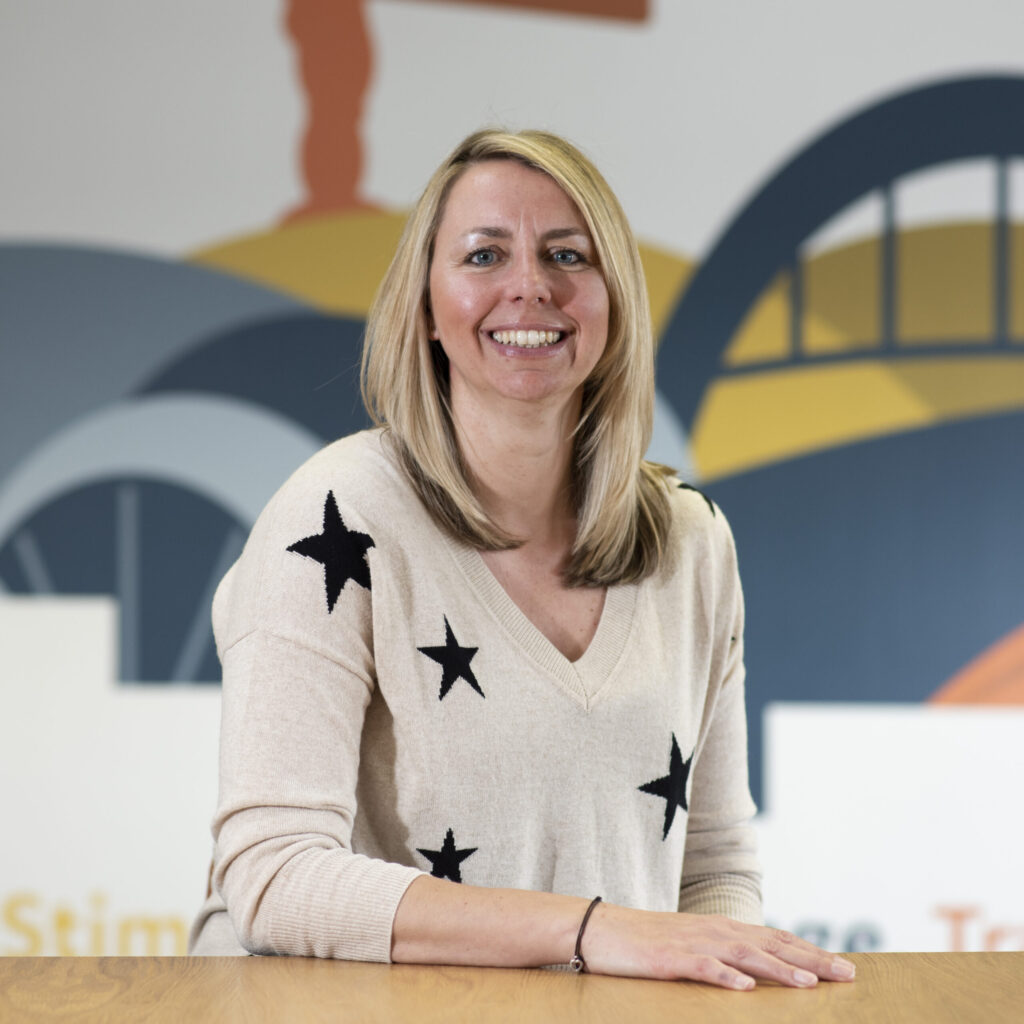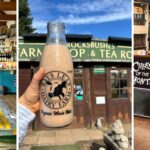- Work Hard
- 27th Apr 2022
- 1.7k Views
- 0
- 10 minutes
HLN meets… Maureen Robson-Norman, Chief Engagement Officer at whyaye

No hierarchical structure. No managers. We find out about the learning organisation style of business at whyaye, and how focusing on its people first is delivering them pretty incredible results.
As the founder of a start-up who has worked in corporate businesses most of my career, this is one of the most interesting interviews I’ve ever done.
Maureen Robson-Norman and the 80+ team at whyaye are running a business with a structure I’ve never seen before. And it’s really working. Since launching in May 2019, they’re on track to turnover between £9-10million this year, with all profits being reinvested back into the business.
They’ve disrupted the traditionally uber-corporate financial services industry with their unusual name, fun branding and different approach. But most interesting is their business structure.
You won’t find any organisational charts here. Everyone is part of a ‘pod’, which works with other pods across the business.
No managers either. Everyone is assigned a buddy when they first start with the business, and after six weeks they can choose their own Personal Development Mentor.
This is a forward-thinking business, no doubt about it. Here, Maureen tells us how she developed the idea, sharing real insight into the culture that the business has developed…
First of all, can you give us an overview of the business and what you do?
ServiceNow is a product that connects people, functions and systems across an organisation. In my role as a consultant, I started working to deliver ServiceNow in different businesses including Shell and Lloyds PLC. This was when my two co-founders and I identified a gap in the market. Many of the large global service implementers will deploy teams on-site to implement the product, but won’t provide any thought-leadership or direction and importantly, they don’t drive employee communications to ensure engagement and successful adoption.
We set the business up in May 2019 and got our first client in October 2019 which was a multinational consumer goods company. Today, we directly employ just over 80 people and have in excess of 20 clients.
Our primary focus is really getting businesses to understand how to use ServiceNow to the best effect. It’s an incredibly powerful system which can bring great efficiencies to a business when used to its full potential. We have specialists in digital transformation, HR, risk and resilience. We have expertise in joining those up as well as drilling down deep into the specific areas and connecting with other systems.
We’re known for getting companies to adopt the usage of the ServiceNow product really well and a key reason for this is the time we spend developing learning pathways and programmes to get each member of staff in the organisation to use it well and continue training as the product develops.
So part of your ethos is to get the best people, wherever they are. Can you tell me more about that?
We employ people from all over the country – from Exeter to Bognar Regis, Edingburgh to Glasgow and everywhere in between. We’ve always had the ethos of focussing on people, their attitude and their approach rather than where they are located.
That said, we do have an agenda where we want to generate more jobs in the North East and have recently taken on a couple of apprentices from Baltic Apprenticeships who have been excellent. We’re focusing on trying to drive up local graduate recruitment and are just about to roll out an academy where we train people ourselves.
Traditionally if people in the North East wanted to work in this industry they would have to move to London and we’re helping to change that.
I’m also very keen to get more women into the industry. We’ve recently taken on a lady through ServiceNow’s Next Generation Programme which works to target certain communities, like refugees, and help them into skilled work. They provide eight weeks of training then we have the opportunity to meet with them and offer them employment.
This lady is 55-years-old and decided to completely restart her career. Her husband runs a restaurant and she has had 20 years out of work raising their family. She works with us now in a very technically specific role and ultimately, that’s it for me. A lot of women think when they get older it’s too late to change their career but I want to help them understand that there are other options. Working in tech can be an option. No one is written off.
And what about the structure of the business because it’s pretty different from what most people are used to?
That’s right. As an organisation we don’t have a hierarchy or management structure. We have what we call a Network Member Orientated Business.
That doesn’t mean we don’t have structure, we do, but for us, that structure isn’t about managing people, it’s about helping people to develop and learn.
On someone’s first day with us, they’re allocated a buddy for six weeks. That buddy is responsible for helping them navigate their way around the company and showing them how to use our systems. At the end of the six weeks, the individual can choose who they want their Personal Development Mentor to be, and after that, they work with the mentor to work out a development plan for their role. Everyone is part of a home ‘pod’ and those pods all work with each other and connect every day.
What we’ve found is that this sense of support, ownership and autonomy means that the organisation almost runs itself. The lead team ensures that operationally everything is in place and working smoothly – so payroll, HR policies, expenses and communications – and the individuals and their mentors look after themselves.
They’re adults and we pay them to come and do a job in an area where they are an expert or becoming an expert. Why should we be telling them how to do their job when that’s the reason we employ them? By giving them that trust and autonomy, they know they are adding value and are a really important part of the organisation, they’re not just a resource.
And everyone works remotely?
Our plan was always to be remote working because typically consultants will be either on-site with the client or working from home. Even pre-pandemic, we didn’t see the need for an office.
However, Covid-19 did take remote working to the extreme. We run large planning events with 90 people in a room involving lots of post-it notes and creative thinking. Like everyone, we had to adapt to doing it online and virtually which worked really well but there’s no replacement for getting in a room together and we’re getting back to doing that now.
What we found during the pandemic was that even though everyone was happy working from home, there can be times when there’s a need to co-create and generate ideas which just doesn’t happen as easily via a screen.
So we came up with the idea of having a hub which we’ve now opened at The Toffee Factory in Ouseburn. It’s not a 9-5 office – it’s very much designed and furnished to generate a sense of co-working, collaboration and creativity.
With 80+ members of staff and growing, how do you communicate with everyone effectively with a remote working model?
Like any organisation, we’ve got a neurodiverse set of individuals who all engage in different ways. Some people like to read in-depth communications, whilst others prefer to listen – so we put a big focus on a multi-channel approach to communication.
We have a weekly business update on a Friday afternoon where we’ll spend 45minutes giving an update on where we are, then do a round-robin to do ‘yays’ and ‘nays’ – what went well and what didn’t go so well that week. Following that, we do what we call a whyaye worship – where any team member can give praise to a teammate who helped them during the week.
Then after that, we have a weekly social and have a drink, a piece of cake or a cup of tea together. We’re always trying to find new ways to make sure we’re including everyone.
We’ve got a working group with different neurodiverse members on it. Everyone shares their experiences on what form of communication works best for them. So for example we have a member with Autism and he’s shared how he likes to receive information, so there are always channels to make sure everyone is involved to be able to learn and engage.
Diversity, equality and inclusion is recognising that every single individual is different regardless of their skin colour, gender or origin. For me, I’m most interested in a person’s neurodiversity and finding out what helps them to learn, grow and engage as an individual.
Where did the idea for this structure come from?
I did my MBA at Newcastle University Business School 12 years ago and we did a lot of work on the learning organisation as a concept.
I’ve worked in corporate businesses for most of my life and it occurred to me that there aren’t many businesses that adopt the learning organisation style which is about being very self-aware, very open to feedback and learning from mistakes or events that have happened and taking that learning to improve and progress.
If someone at whyaye makes a mistake or a customer gives us some bad feedback, we’re very much of the ilk where we’ll put our hands up and say ‘Great, now what do we need to do to stop that happening again?’ So we would say to the individual ‘don’t do that again’, we’d say ‘ what support do you need’.
Well, you’ve certainly disrupted the market in a short space of time, with some impressive clients on board. Why do you think they work with you over the more traditional firms?
There’s definitely an agility aspect. We can respond much more quickly. We don’t go in from the perspective of ‘we know it all and can tell you how to do it’.
We tell them that we have great experience that we can share, but every client case is unique so we’ll work with you and share our skills. We go on a journey with each client and work towards getting them to a point where they no longer need us.
We have a very different approach which is simple and output focused. We demonstrate value quickly rather than doing months of discovery work. We’re very honest and transparent – our clients know that we aren’t afraid to be completely open and like the style that we have.
Most of our work comes from referrals between clients who like our different approach. We aren’t corporate and deliberately went out to be different in our branding to really hammer home that we are different.
So what’s next?
We’ve got a growth strategy in terms of what sectors we want to work in and where we want to get to in terms of size. We review this on an annual basis and have outgrown it every year so far. But really the view is to continue what we’re doing for the next two years.
Personally, I’m really interested to see where we get to in terms of size before the culture starts creaking. I have a suspicion that may be when we get to 200 employees but who knows? I guess we’ll find out…
For more information visit the whyaye website, or check them out on Instagram and LinkedIn.










Comments